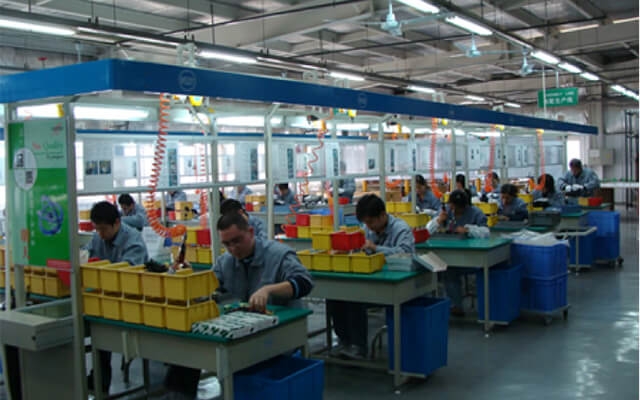Service Overview
As well as high volume manufacturing facilities within its automated powder coating, CNC machining and high pressure casting production centres Hallam Castings also offers volume component assembly of components into sub-assemblies or finished products.


Sub-assemblies include housing sets for electronic equipment, ready for electronic components to be fitted to complete the product assembly and fixtures or strengthening components used in the construction sector, ready for use. Finished products supplied boxed and ready for delivery include computer monitor arms for installation in office suites or for retail sale and LED-based lighting products for industrial or commercial use.
Such component assembly products can be provided in volume for stock buffering or, in terms of Hallam’s overall “lean” framework, on a Just in Time (JIT) basis to avoid overstocking waste using Kanban systems where possible. A natural extension of the JIT approach is delivery directly to the final user (or installer) on behalf of Hallam’s customers. Office equipment, lighting and construction products are often delivered directly to the installation site. Similarly domestic lighting products are delivered directly to the retail consumer.
Key elements of efficient finished product and component assembly production at Hallam are:-
- Reliable and well maintained machinery and equipment
- Well designed work cells
- Empowerment of work teams over quality and efficiency issues. “Kaizen” events can be set up to reinforce this.
- Standardisation of operations
- Integration of Quality, Health and Safety and Lean efficiency coaching and work instruction signage.
- Work flow levelling
- Cycle time monitoring and comparison. “Yamazumi” charts can be used to show this.
Hallam’s drive for continual improvement is based on reducing:-
- Inventory and space costs
- Processing and handling costs including machine set up times and costs
- Planning costs through simplifying integration with customer MRP systems
all underpinned by the development of close working relationships with customer design teams and production engineers so that DFM issues can be identified at the earliest possible stage of the customer product lifecycle.
High Volume Manufacturing Solutions
Hallam Castings specialises in high-volume manufacturing across a range of production processes, including automated powder coating and CNC machining and high-pressure aluminium casting. Hallam employs lean techniques in process system design and all aspects of manufacturing. Hallam offers high-volume component assembly, turning individual components into finished products or sub-assemblies ready for delivery to end customer or site.
Expertise in High Volume CNC Machining
Hallam’s high-volume CNC machining centres are equipped to handle complex manufacturing challenges. Advanced machinery combined with well-planned work cells ensures efficiency and precision. Hallam applies lean through Just-in-Time and Kanban systems for minimal stocking.
Why Choose Hallam Castings for High-Volume Manufacturing?
Hallam offers a full range of processes for the manufacture and assembly of components into sub-assemblies or finished products. Sub-assemblies include housing sets for electronic equipment and structural components for the construction sector. Sub-assemblies are prepared for further integration with structural or electronic components or direct usage at the place of installation.
Leading Medium-size Manufacturing Companies in the UK
Hallam Castings is one of the most successful B2B medium size manufacturing companies in the UK, producing high-quality products and components for a wide range of industry sectors. A high-value manufacturing approach enables Hallam to stay at the forefront of technological innovation and drive the effectiveness of production. Hallam works closely with customers’ design teams and production engineers to address Design for Manufacturing (DFM) issues early in the product lifecycle. This also ensures seamless integration with customers’ manufacturing and supply chain systems. Hallam provides customers with competitive manufacturing and supply solutions by way of delivery directly to the installation site or the end consumer. This is beneficial in industries such as office equipment, lighting, and construction where on-time delivery is critical.
Variety of High-volume Production Processes
Hallam’s high-volume production processes are varied and adaptable to suit a wide variety of industry requirements. From high-pressure casting to high-volume CNC machining and powder coating Hallam covers an array of manufacturing requirements. Hallam pursues continuous improvement and cost overhead by reducing inventory, space costs, processing and handling, together with integration with customer MRP systems to enhance administrative system efficiency for customers.
FAQ
Hallam specialises in manufacturing high-volume aluminium castings and assembly into sub-assemblies and finished products using a variety of externally sourced components. Finished products include LED lighting systems, office equipment including computer monitor arms, handling equipment and veterinary implements.
Hallam uses lean techniques, including Kanban systems to avoid overstocking, to ensure that production lines run efficiently and that waste is eliminated. Hallam constantly monitors machine cycle times and the levelling of workflows.
Hallam uses only state-of-the-art machinery within its CNC processing unit. Work cells and process flows are designed using lean principles for precision and efficiency in performance. Hallam is committed to offering only the best in high volume manufacturing services.


